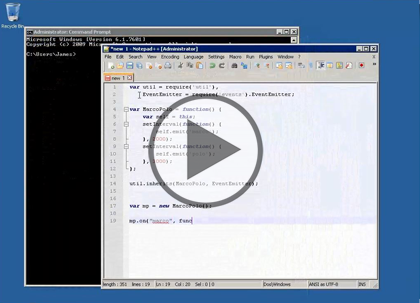Course description
In this course we’ll cover using Buffers in Node.js, including copying, decoding and events. We’ll then move on Server Requests, building a file server, creating HTTP requests and closing out the course we’ll cover how to build a web application using ExpressJS. This course is done from the perspective of a Microsoft technologies developer getting into node.js and all it has to offer.
Prerequisites
This course assumes that users have an understanding of developing applications using C#, C++, Java, and JavaScript in a Visual Studio development environment.
Learning Paths
This course is part of the following LearnNowOnline SuccessPaths™:
JavaScript Frameworks
Meet the expert
James Curtis is a .NET Developer that primarily works in the UX space. He has worked on and for several large projects alongside Microsoft Consulting. James has spoken at several code camps about UX development for ASP.NET and SharePoint. He is an active participant in the development community tweeting and blogging about several topics in the UX area. James is an active consultant and is also assisting in several Start-ups contributing his UX experience.
Course outline
Buffers
Buffers (19:23)
- Introduction (00:23)
- Node Buffers (02:25)
- Creating a Buffer (00:58)
- Demo: Buffer (02:12)
- Get and Set Bytes in a Buffer (01:34)
- Demo: Get Bytes (04:42)
- Demo: Set Bytes (02:02)
- Buffer Slicing (01:22)
- Demo: Buffer Slicing (03:20)
- Summary (00:20)
Buffer, Copying, Decoding (08:02)
- Introduction (00:18)
- Buffer: Copying (00:30)
- Demo: Copy (03:37)
- Buffer: Decoding (00:29)
- Demo: Decoding (02:48)
- Summary (00:16)
Events (22:26)
- Introduction (00:16)
- Creating an Event Emitter (01:04)
- Demo: Create an Event Emitter (05:51)
- Event Emitter API (00:40)
- Demo: Event Emitter API (04:22)
- Demo: Multiply Listeners (04:57)
- Event Emitter Pattern (01:21)
- Event Types (01:45)
- Demo: Event Types (01:49)
- Summary (00:15)
Servers
Server Requests (09:54)
- Introduction (00:21)
- Building a HTTP Server (01:03)
- Demo: Create HTTP Server (04:53)
- HTTP Server Requests (01:01)
- HTTP Server Response (02:16)
- Summary (00:17)
Building a File Server (17:12)
- Introduction (00:19)
- Building a File Server (01:47)
- Demo: Create Server (05:14)
- Demo: File System (04:07)
- Demo: Nonexistent File (01:36)
- Demo: System Test (03:44)
- Summary (00:22)
HTTP Request (20:22)
- Introduction (00:21)
- Creating HTTP Requests (03:33)
- Demo: GET Request (04:12)
- Inspecting the Response (00:57)
- Demo: Another Request (04:28)
- Demo: Response (02:57)
- Demo: Stream Response (03:34)
- Summary (00:18)
Express JS (31:03)
- Introduction (00:25)
- Demo: GET Request (04:38)
- Demo: POST Request (03:44)
- Demo: Regular Expression (04:40)
- Demo: Jade (03:59)
- Demo: Passing Objects (02:08)
- Demo: Layout (03:41)
- Working with Express.js (01:17)
- Demo: Install Express.js (02:41)
- Demo: Express.js (03:22)
- Summary (00:23)



